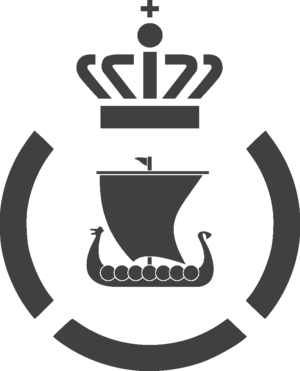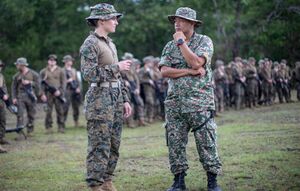Royal Acrean Marine Corps: Difference between revisions
No edit summary |
No edit summary |
||
| Line 4: | Line 4: | ||
|caption = | |caption = | ||
|motto = | |motto = | ||
|dates = 21 March | |dates = 21 March 1888 - Present (Royal Marine Corps) | ||
|country = {{flag|Acrea}} | |country = {{flag|Acrea}} | ||
|type = {{wpl|Marines}} | |type = {{wpl|Marines}} | ||
| Line 28: | Line 28: | ||
}} | }} | ||
The '''Royal Acrean Marine Corps''' is the expeditionary | The '''Royal Acrean Marine Corps''' is the expeditionary component of the [[Acrean Armed Forces]]. | ||
==Mission== | ==Mission== | ||
| Line 36: | Line 36: | ||
==History== | ==History== | ||
Despite its classification as a naval infantry, the RAMC formally traces its descent to the [[Acrean Army]]. Prior to the formal establishment of the RAMC, Acrean marines consisted of a few regiments of naval infantry under the [[Acrean Navy|Navy]], and were employed for conducting coastal raids, conducting and defending against boarding actions, and establishing beachheads. | |||
The RAMC was created in 1665 as an expeditionary force capable of defending Acrea's rapidly expanding overseas territories. The new addition of [[Lemobrogia]] as a protectorate to Acrea's colonial sphere of influence in Siduri necessitated a larger security force than that in neighbouring [[Erania]], where Acrean troops were bolstered by a sizeable indigenous Eranian force. At the behest of the the Acrean Army's general staff, the Riksdag raised several regiments of naval infantry from the ranks of the Army to form the first "Corps of Marines". The force grew past the size of a single corps halfway through the 18th century, and was reorganised into its own independent branch in 1888. | |||
==Doctrine== | ==Doctrine== | ||
| Line 42: | Line 45: | ||
==Personnel== | ==Personnel== | ||
Revision as of 16:33, 30 November 2023
| Royal Acrean Marine Corps Marinekåren Corps de Marines | |
|---|---|
 | |
| Active | 21 March 1888 - Present (Royal Marine Corps) |
| Country | |
| Type | Marines |
| Size | 170,800 active duty personnel 80,348 reserve personnel 251,148 total |
| Part of | Acrean Armed Forces |
| Headquarters | Rena |
| Engagements | Kunhegyes Conflict Ruvelkan Civil War Great Eracuran War Liberation War Refusal War Zemplen War Midsummer War Continuation War |
The Royal Acrean Marine Corps is the expeditionary component of the Acrean Armed Forces.
Mission
The RAMC is responsible for conducting expeditionary and amphibious operations. It possesses its own organic infantry, armour, artillery, special operations, and aviation forces which coordinate with navy assets in order to conduct their mission. The RAMC is unique in possessing its own fixed-wing combat aircraft separate of the RAAF. In combination with its engineering and construction units, this allows combat aircraft to be deployed from temporary or ad hoc airfields such as highway strips. The RAMC's expeditionary missions mean that it's the force most frequently deployed on overseas operations, and are responsible for continuous overseas operations involving Acrea's former territories. Secondary to its expeditionary and rapid deployment roles, the RAMC is frequently used to support the Army during ground operations in the event of a major conflict, and has been deployed in force alongside the Army in every major conflict Acrea has been involved in.
History
Despite its classification as a naval infantry, the RAMC formally traces its descent to the Acrean Army. Prior to the formal establishment of the RAMC, Acrean marines consisted of a few regiments of naval infantry under the Navy, and were employed for conducting coastal raids, conducting and defending against boarding actions, and establishing beachheads.
The RAMC was created in 1665 as an expeditionary force capable of defending Acrea's rapidly expanding overseas territories. The new addition of Lemobrogia as a protectorate to Acrea's colonial sphere of influence in Siduri necessitated a larger security force than that in neighbouring Erania, where Acrean troops were bolstered by a sizeable indigenous Eranian force. At the behest of the the Acrean Army's general staff, the Riksdag raised several regiments of naval infantry from the ranks of the Army to form the first "Corps of Marines". The force grew past the size of a single corps halfway through the 18th century, and was reorganised into its own independent branch in 1888.
